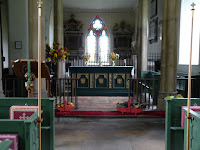
 Winifred Holtby was born in Rudston and was a writer. Her bestselling novel, South Riding, was written using Rudston as a backdrop. She was born in 1898 and died at the young age of 37 in 1935 and was buried in the churchyard. Sadly, she knew she was dying when she wrote the book and it was published after her death.
Winifred Holtby was born in Rudston and was a writer. Her bestselling novel, South Riding, was written using Rudston as a backdrop. She was born in 1898 and died at the young age of 37 in 1935 and was buried in the churchyard. Sadly, she knew she was dying when she wrote the book and it was published after her death.I read the book years ago but, sadly, can't find my copy now. It is back in print so I might be tempted. It gives a good view of life in 1930s England and her writing is superb.




